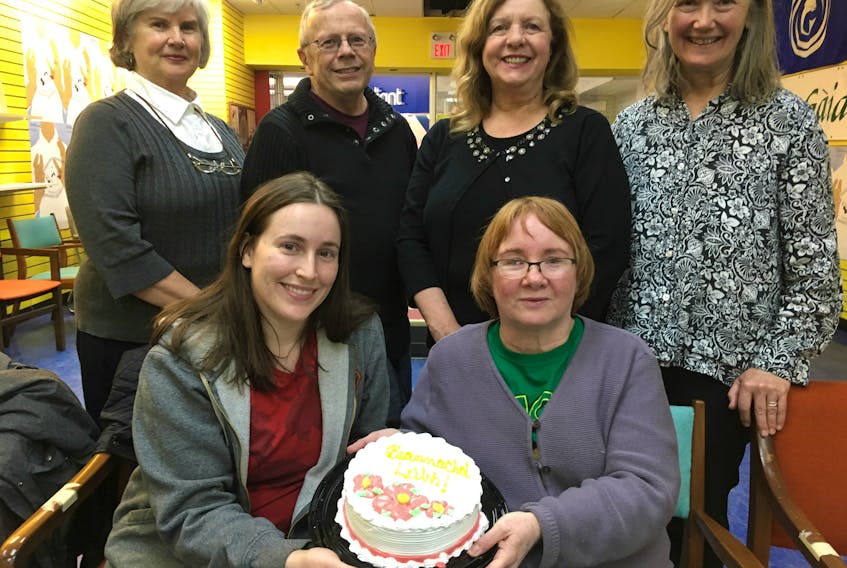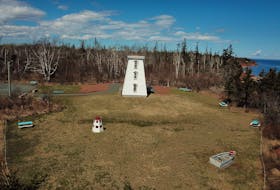Whether from a love of the music, a sense of homage to heritage or a simple curiosity about languages, a group of beginner students gather once a week to learn Gaelic.
Most have ancestors who once spoke the language but the closest claim any of them have is to grandmothers they never met who reportedly had the Gaelic.
Wendy McInnis considers herself a Gaelic learner but is also the class instructor.
“I’m working toward becoming fluent. Once you start the Gaelic journey, you just can’t stop.”
She grew up in Trenton, a town which once had many Gaelic speakers, some having come from Antigonish and Cape Breton to work in the local industries.
“I’d be at my friend’s house and I’d hear her father speaking Gaelic to the oldest son. The son, Cal MacInnis, was learning the language from his father, one of the last native speakers in the town.”
A university course in Celtic folklore later increased her appreciation of the culture.
“Culture and language go hand in hand. So many of our old myths and fairy tales are from the Celtic realm.”
Elaine Chaisson, who helps instruct the class and also teaches a small beginners’ class in Pictou, worked at the Hector Heritage Quay in Pictou for eight years.
“Many people who came to visit had a great interest in the language and I knew it had been spoken by one of my grandmothers in Cape Breton, so I gradually developed my own interest. Given we have such a Scottish history, I felt I should learn as much as I can.”
Both have spent years taking advantage of every possible opportunity to enhance their language skills, including workshops and immersion weekends.
Wendy, who works at NSCC, once got a year’s leave of absence to study Gaelic.
“I did everything I possibly could during that year, including attending classes at St. FX and in Cape Breton,” she said, adding she also spent three weeks in an immersion program on the Isle of Skye.
For Chaisson one of the highlights of her learning was spending days with a couple of native speakers including Joe MacKinnon of Antigonish, who grew up with the language in Inverness.
“To be around people who spoke so naturally was very exciting. It was hard but very enjoyable.”
Once a month the students have a day-long immersion session and they will all be spending an immersion weekend at Colaisde na Gaidlig/The Gaelic College in St. Ann’s.
Beth MacEachern’s background is highland Scottish but she isn’t sure how far back she’d have to go to find a Gaelic speaker in her family.
“I like languages and try to learn a few words of the local language if I am travelling but it is an interest in Gaelic music and song that drew me in,” she said.
Bruce Laidlaw is a bagpiper who grew up in Dartmouth and more recently lived in Calgary.
“There is a revival in the Celtic arts in Calgary. I think we had eight pipe bands when I left.”
He took two years of Gaelic classes in Calgary and when he left the oil business to take a job with Sobeys he seized the opportunity to brush up on his skills after an eight-year hiatus.
“My people came from southeast of Glasgow so I doubt they ever spoke Gaelic but I’ve always been interested and this seems like a good place to learn,” he said.
Linda Turner, a newcomer to Pictou County, came across the Gaelic class while looking for ways to make new acquaintances.
“I’m from Ontario and in the past, I learned that in the 1901 census my great-grandfather, in Wiarton, Ont., gave Gaelic as the language of the home. That made an impression on me so given the opportunity, I’m quite excited to learn some Gaelic.”
Anna MacKenzie’s Scottish highland roots go deep in Pictou West.
“My great-grandparents in Braeshore were Gaelic speakers and I’ve been interested for a long time. I’ve taken courses before and it is my third time taking these sessions. I just love anything to do with the language including the songs, the dances and the milling frolics.”
McInnis said people in Pictou County have been learning Gaelic in one form or another for the past quarter century.
“There has always been an interest and we’ve learned through whatever was available at different times. Sometimes we’ve had paid instructors and at other times we have volunteers. For three years we had Celtic studies professor Michael Linkletter coming from St. FX to teach us. We also had Hector MacNeil conduct one-day-a-month immersion programs for three years.”
Other instructors from the past 15 years have included Calvin MacInnis, Joe Murphy, Hector MacNeil, Lewis MacKinnon, Angus MacLeod, Debbi Sobey, Shay MacMullin and Stacey MacLean. Sobey currently teaches intermediate level classes and MacLean conducts once a month immersion programs locally.
“Some of us have also taken courses through the online programs of the Atlantic Gaelic Academy. Depending on how you have learned, you may have studied a lot of grammar or you may have strong oral skills but be less able to read.”
In her experience, it is song lyrics that people most often want to read.
“They may really enjoy an old song and want to be able to read the lyrics to get the meaning of the song and understand its history.”
Song workshops have been among the most popular Gaelic activities organized.
McInnis pointed out the online resources for those interested in Gaelic have increased substantially in recent years.
While there are flags and posters and learning charts on the walls of the room at Aberdeen,
Chaisson suggested the popularity of the Outlander television series, based on the books of Diana Gabaldon, has increased interest in all things Celtic.
“It is a very popular series and there are all sorts of activities based around it so it has created new interest.”
While there are flags and posters and learning exercises, such as naming body parts, on the walls of Aite nan Gaidheal where classes are held, the atmosphere is informal.
“We’re here to learn and practise and to share. Nobody is here to be tested and the goal is just to take away what you can. Hopefully, you will come back and build on what you have learned,” said McInnis.
Rosalie MacEachern is a Stellarton resident and freelance writer. She seeks out people who work behind the scenes on hobbies or jobs that they love the most. If you know someone you think she should profile in an upcoming article, she can be reached at r[email protected]









